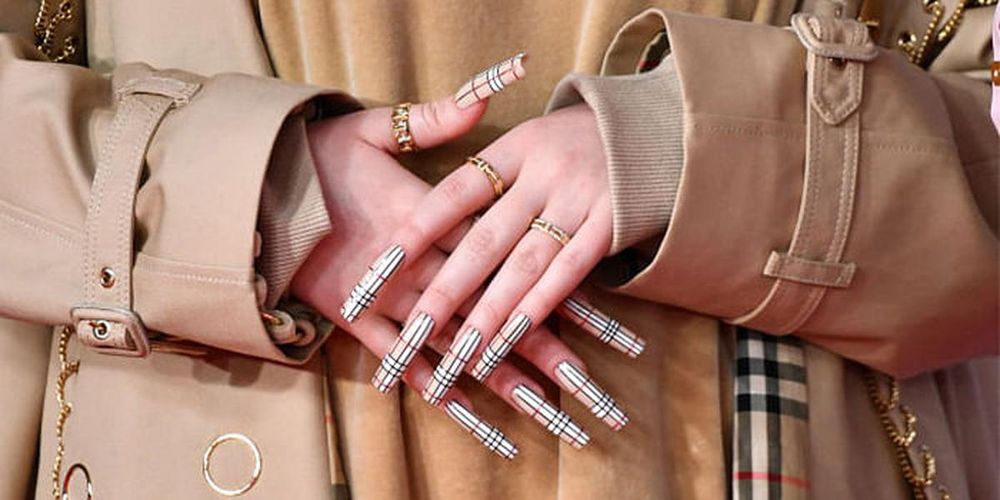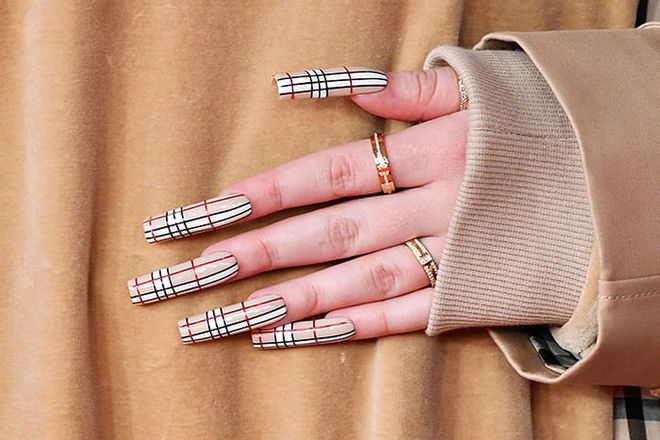

Billie Eilish's nails details at The BRIT Awards 2020 at The O2 Arena. Photo: Getty
The Beginner's Guide to Acrylic Nails
Acrylic nails have been around for decades, but they’ve had a resurgence in recent years thanks to a combination of celebs, Instagram, and our collective nail art obsession. Great for those looking to add length and strength to their nails, acrylics can also create a larger, more evenly shaped canvas for those who love intricate nail designs. Thinking of trying out the look? We asked Hannah Lee, Sally Hansen nail expert and professional manicurist, to break down the process, how to keep them in tip-top shape, and all the other good-to-knows.
What Are Acrylic Nails?
Quick science lesson: Acrylics are a combination of a liquid monomer and a powder polymer that form a paste which is bonded to the natural nail. It's then given the desired shape, where it hardens in place to add strength, length, and thickness to the nail.
How Are Acrylic Nails Different Than Gel Nails?
Both add a strengthening layer to the nail, but gels require a UV light in order to set. "Acrylics are much stronger than gel which makes them more durable," says Lee. "If you are looking to extend your nail quite a bit, then you would want acrylics, but if you're going for more of a natural look, gel is what you'd want.”
Related article: The Ultimate Guide To The Best Watch Brands
Are Acrylic Nails Safe?
“Acrylics do get a bad rap, but really, they aren't any worse for your nails than other artificial nail products,” says the manicurist. However, they aren’t completely without side effects—which worsen if you don’t take the right steps to take care of them. “The removal process can weaken your nails’ natural state, but when done properly it won't cause any permanent damage, which is why it's very important to have a professional remove them,” she explains. Aside from safe removal, one of the best things you can do for your natural nails is to take occasional breathing space between appointments. “It’s recommended to take a break from getting acrylics around every three to six months to help rejuvenate your nails,” recommends Lee.
How Long Do Acrylic Nails Last?
“Acrylics should last six to eight weeks with a fill needed about every two to three weeks, depending on your nail growth,” says Lee. Not only does getting a fill—a.k.a. a touchup between the bottom of the nail and the cuticle—improve the appearance of the manicure, but it also helps it last longer. “Fills are very important because once your nails start to grow is when lifting begins to happen,” says Lee.
Related article: BAZAAR Style Guide: How To Get The Most Wear Out Of Your Buys
How Can You Make Acrylics Last Longer?
Contrary to popular belief, you can still use your hands when you have acrylics, however Lee recommends wearing gloves while doing things like cleaning. “Also, use moisturizer and cuticle oil to keep your hands and nails healthy. I love Sally Hansen's Vitamin E Cuticle Oil,” she says.
As with any treatment, do your research on the salon—the right care and attention to detail can help extend the life of your manicure in the long run. Beyond that, the biggest enemies to acrylics are wearing them beyond their lifespan and not keeping up with fills, says Lee.
What's the Best Way to Remove Acrylics?
Whatever you do, resist the urge to pluck them off yourself. “The best and safest way to remove acrylics is to go to your nail professional to get them properly removed,” stresses Lee. “It's important to not try to peel them off yourself or remove them in an unsafe way because it can cause damage.” It takes a bit more time and effort than typical polish removal, but it’s worth it. “Your nail tech will most likely use an electric file to remove the top layer of the acrylics. Then, your nails are typically wrapped in foil with an acetone-filled cotton ball inside to soak for about 15 minutes. A cuticle pusher is used to remove any excess acrylic followed by cuticle oil to rehydrate the nails.” Then, you’re good to go—with your natural nails mercifully still intact.
This article originally appeared on Harper's Bazaar US.
Related article: The Ultimate Guide To The Most Coveted Jewellery Brands